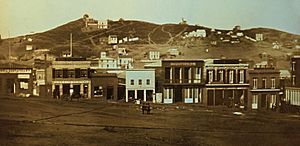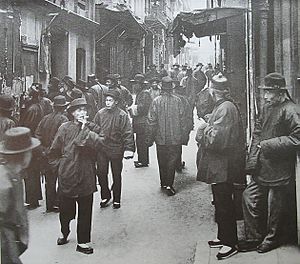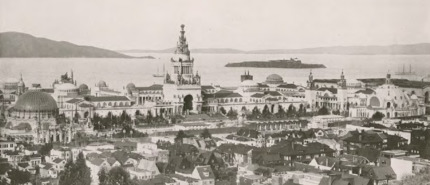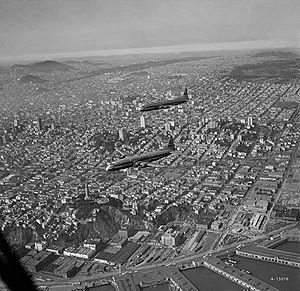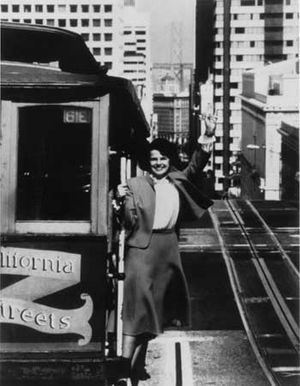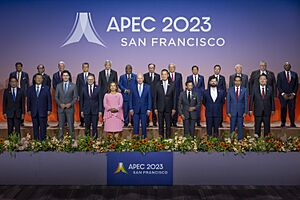History of San Francisco facts for kids
The city of San Francisco, California, is located at the entrance to a large natural harbor. This special location helped it grow into an important center for maritime trade (shipping goods by sea). San Francisco is both a city and a county, sharing the same borders.
At first, not many European-Americans lived here. But after the California gold rush in 1849, San Francisco quickly became the biggest and most important city in the American West. It was a major center for people, businesses, the navy, and money.
In 1906, a huge earthquake and fire destroyed much of San Francisco. But the city was rebuilt very quickly! The San Francisco Federal Reserve Branch opened in 1914. The city kept growing as a big business hub through the first half of the 1900s.
Starting in the late 1960s, San Francisco became famous for the hippie movement. In recent years, it has become a key center for finance and technology. Because it's close to Silicon Valley, housing is in high demand. This makes San Francisco one of the most expensive places to live in America.
Contents
- Early Days and First People
- European Arrivals and Early Settlements
- The 1848 Gold Rush
- The "Paris of the West" Era
- The 1906 Earthquake and Fire
- Panama-Pacific Exposition of 1915
- The 1930s and World War II
- After World War II
- The 1960s and 1970s
- The 1980s
- The 1990s
- The 2000s
- The 2010s
- The 2020s
- Historic Populations
Early Days and First People
The first signs of people living in what is now San Francisco date back 5,000 years ago. Native Americans, known as the Ohlone people, settled here. They found the bay was a great place to hunt and gather food. They set up many small villages. The Ohlone spoke a language from the Miwok family. They traded with people as far away as Baja California and Yosemite.
The first Europeans to arrive were a Spanish group in 1769. They were led by Don Gaspar de Portolá and Fra. Juan Crespi. The Spanish saw that this location, with its big natural harbor, was very important for defense.
Another Spanish trip, led by Juan Bautista de Anza, chose spots for military and religious settlements in 1774. The Presidio of San Francisco was built for the military. Mission San Francisco de Asís (also known as Mission Dolores) was started to teach the Ohlone people about Spanish culture and religion.
The first port was set up at a small inlet. A small town grew nearby called Yerba Buena. It was named after an herb that grew there. The main square of this Spanish town is still Portsmouth Square today. The city later took its name from the mission. Yerba Buena is now a neighborhood called South of Market.
San Francisco became part of the United States when the Treaty of Guadalupe Hidalgo was signed in 1848. This treaty ended the Mexican-American War.
European Arrivals and Early Settlements

The Portolá expedition was the first European group to see San Francisco Bay. They arrived on November 2, 1769. Portolá claimed the area for Spain.
A second group of Spanish soldiers and settlers arrived in June 1776. They were led by Juan Bautista De Anza. One of his officers, José Joaquín Moraga, was told to build the Spanish mission, Mission San Francisco de Asís, and a military fort, the Presidio of San Francisco.
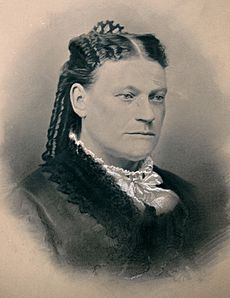
In 1786, French explorer Jean-François de Galaup, comte de Lapérouse visited San Francisco. He wrote a detailed report about it. Six years later, in 1792, British explorer George Vancouver also stopped in San Francisco. Russian fur traders also visited the area. The neighborhood Russian Hill is named after Russian traders and sailors whose remains were found there.
After Mexico became independent from Spain in 1821, the area became part of Mexico. In 1835, an Englishman named William A. Richardson built the first important home outside the Mission Dolores area. It was near a boat dock around what is now Portsmouth Square. He helped plan streets for the growing town, which was called Yerba Buena. American settlers started to move there.
On July 31, 1846, Yerba Buena's population doubled. About 240 Mormon pioneers arrived on the ship Brooklyn. They were led by Sam Brannan. Brannan later became famous for being the first to publicize the California Gold Rush of 1849.
The US Navy claimed California for the United States on July 7, 1846. Two days later, US Navy Captain John Berrien Montgomery claimed Yerba Buena. He raised the American flag over the town plaza, which is now Portsmouth Square. On January 30, 1847, the name Yerba Buena was officially changed to San Francisco.
The city and California officially became American in 1848. California became a US state on September 9, 1850. San Francisco and San Francisco County were then created.
The 1848 Gold Rush
The California gold rush began in 1848. This led to a huge increase in San Francisco's population. Between January 1848 and December 1849, the city's population grew from 1,000 to 25,000! This fast growth continued through the 1850s.
Many workers from China came to work in the gold mines. Later, they helped build the Transcontinental Railroad. The Chinatown area of the city became one of the largest in the country. Today, about one-fifth of the city's population is Chinese.
Many businesses started during this time to serve the growing population. Some famous ones still exist today, like Levi Strauss & Co. (clothing), Ghirardelli (chocolate), and Wells Fargo (bank). Rich railroad, banking, and mining leaders like Charles Crocker and Leland Stanford settled in the city's Nob Hill neighborhood. Their former mansions are now famous hotels.
The rapid growth made city planning difficult. This is why San Francisco still has many narrow streets today.
The "Paris of the West" Era
From the 1860s to the 1880s, San Francisco grew into a major city. New neighborhoods like the Western Addition and the Mission District were created. Golden Gate Park was built in 1887.
The city's famous cable cars were built around this time. They were invented by Andrew Smith Hallidie to help people travel up and down the city's steep hills.
San Francisco also became a cultural center. Famous writers like Mark Twain and Robert Louis Stevenson spent time in the city. The San Francisco Stock and Bond Exchange was founded in 1882.
By the 1890s, San Francisco faced problems with political corruption. Adolph Sutro became mayor in 1894. He tried to improve the city, but didn't have much success. The next mayor, James D. Phelan, was more successful. He helped pass a new city plan that allowed for money to be raised for new sewers, schools, parks, and a hospital. After his term, Phelan wanted to make San Francisco a grand "Paris of the West."
In 1900, a ship brought rats infected with bubonic plague to San Francisco. This caused the first plague outbreak in the U.S. City leaders banned burials within the city, moving cemeteries to the town of Colma, California just south of the city. A part of Chinatown was quarantined. The outbreak ended by 1905.
The 1906 Earthquake and Fire
On April 18, 1906, a terrible earthquake struck. It was caused by the San Andreas Fault breaking for over 270 miles. The earthquake's center was just off the coast of San Francisco. Scientists estimate it was a magnitude 7.8 earthquake.
Water pipes broke all over San Francisco. Fires started and burned out of control for days. About 80% of the city was destroyed, including almost all of downtown. Many people were trapped between the bay and the spreading fires. A huge evacuation across the bay saved thousands of lives.
Temporary camps were set up in Golden Gate Park and other open areas. The official death count was later updated to more than 3,000 people. This was the deadliest natural disaster in California's history.
Panama-Pacific Exposition of 1915
In 1915, San Francisco hosted the Panama–Pacific International Exposition. This event celebrated the opening of the Panama Canal. It also showed off how well San Francisco had rebuilt itself less than ten years after the earthquake.
After the fair, most of its grand buildings were taken down. Only the rebuilt Palace of Fine Arts remains today. The rest of the fairgrounds became the Marina District.
The 1930s and World War II
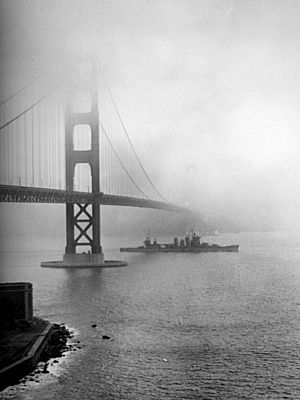
In 1934, San Francisco was the center of the 1934 West Coast waterfront strike. This strike lasted 83 days. It led to all West Coast ports in the United States becoming unionized.
The San Francisco–Oakland Bay Bridge opened in 1936. The famous Golden Gate Bridge opened in 1937. The 1939 Golden Gate International Exposition was held on Treasure Island. During this time, Alcatraz Island, a former military prison, became a federal maximum-security prison. It held famous inmates like Al Capone.
During World War II, San Francisco was a main supply point and port for the war in the Pacific. The city's Japantown neighborhood, home to many Japanese Americans, became empty. This was because of Executive Order 9066, which forced all Japanese Americans to be sent to internment camps.
By 1943, many parts of Japantown were vacant. Thousands of African Americans moved from the South to California for wartime jobs. This was part of the Great Migration. Many settled in the Fillmore District and near the Bayview-Hunters Point shipyards.
The War Memorial Opera House, which opened in 1932, was important after World War II. In 1945, the conference that created the United Nations was held there. The UN Charter was signed nearby. Six years later, in 1951, the Treaty of San Francisco was signed here. This treaty officially ended the war with Japan.
After World War II
After World War II, many American military members who loved San Francisco settled in the city. This led to the creation of new neighborhoods like the Sunset District.
During this time, there were plans to build many freeways in the Bay Area. However, San Francisco's high population density meant that building freeways would force many people to move. In 1959, the city decided to stop building more freeways. This event is known as the Freeway Revolt.
In 1958, the New York Giants baseball team moved to San Francisco and became the San Francisco Giants. Their first stadium, Candlestick Park, was built in 1959.
City Changes
In the 1950s, Mayor George Christopher started a plan to rebuild older parts of the city. This plan aimed to replace working-class neighborhoods with modern buildings. Some people felt this plan caused segregation and forced black residents to move from their homes. Many moved to new housing projects or other cities like Oakland.
This planning led to the creation of Embarcadero Center, Japantown, and eventually Yerba Buena Gardens.
The 1960s and 1970s
After World War II, San Francisco became a popular place for new cultural movements. In the 1950s, City Lights Bookstore was important for the Beat Generation writers.
In the 1960s, San Francisco became the center of the hippie movement. In 1967, thousands of young people came to the Haight-Ashbury district for the Summer of Love. The San Francisco Sound emerged in rock music. Bands like Jefferson Airplane and the Grateful Dead became famous. They mixed folk, rock, and jazz music.
The 1980s
During Mayor Dianne Feinstein's time (1978–1988), San Francisco saw a building boom. Many tall skyscrapers were built, especially in the Financial District. This led to a movement against them, as people felt they blocked views and changed the city's unique look. The city then added rules to limit the height of new buildings.
Mayor Feinstein also helped develop the Moscone Center (a convention center). She also helped preserve and fix the city's Cable Cars.
In the early 1980s, more homeless people started appearing in the city. Mayor Art Agnos (1988–1992) was the first to try to solve this problem. It remains an important issue for San Franciscans today.
In August 1989, San Jose (in Silicon Valley) became larger than San Francisco in population for the first time. San Jose has continued to grow because it has more land for new buildings.
The 1989 Loma Prieta Earthquake
On October 17, 1989, an earthquake hit near Loma Prieta Peak. It measured 6.9 on the moment magnitude scale. The quake severely damaged many of the city's freeways, including the Embarcadero Freeway. Mayor Agnos made the choice to tear down the Embarcadero Freeway, which opened up the waterfront. The quake also caused a lot of damage in the Marina District.
The 1990s
The 1990s saw the damaged Embarcadero and Central Freeways torn down. This helped improve areas like Hayes Valley and the city's waterfront, The Embarcadero. In 1994, the former military base of San Francisco Naval Shipyard was closed and given back to the city. The Presidio became a national park.
In 1996, the city elected its first African American mayor, Willie Brown. During his time, San Francisco's budget grew. He oversaw the development of the new Mission Bay neighborhood. A new baseball stadium for the Giants, AT&T Park, was also built.
The Dot-Com Boom
During the dot-com boom of the late 1990s, many entrepreneurs and computer professionals moved to San Francisco. This changed the city as once poorer neighborhoods became gentrified (improved, but often leading to higher costs). Rising rents forced many people and families to leave. San Francisco has the smallest percentage of children of any major U.S. city.
The 2000s
In 2001, the dot-com boom ended, and many people left San Francisco. The South of Market area, where many tech companies were, became full of empty offices. The city's population dropped by 30,000 in just a few years. While this helped lower apartment rents, the city remained expensive.
By 2003, San Francisco's economy recovered. This was thanks to more tourists and a new "Web 2.0 boom." Many new internet and software companies started in the city. This attracted young adults and workers from all over the world. Housing demand and rents rose again. City officials allowed taller buildings to be built in SOMA.
The 2010s
In 2010, the San Francisco Giants won their first World Series title since moving from New York City. About 1 million people attended their victory parade, one of the largest in city history. The Giants won their second title in San Francisco in 2012.
In 2011, Edwin Lee was elected the first Chinese American mayor of a major American city. Mayor Lee supported both tenants' rights and the growing tech community.
By 2013, San Francisco had fully recovered from the economic downturn. It was experiencing a real estate and population boom. The computer industry was moving north from Silicon Valley. Rental units became very hard to find, and prices rose dramatically. By 2015, San Francisco had the highest rents in the nation.
In April 2016, the city passed a law requiring all new buildings under 10 stories to have rooftop solar panels. This made it the first major U.S. city to do so.
The 2020s
On March 16, 2020, San Francisco was affected by the COVID-19 pandemic. Many residents lost their jobs, and others started working from home. Rent prices fell, and empty apartments increased. That same year, severe wildfires east of San Francisco caused "Orange Skies Day" due to smoke.
The 2023 APEC conference was held in San Francisco.
In March 2024, Macy's, Inc. announced plans to close its Macy's Union Square store. This news was seen as a sign of changes in Union Square as a shopping area.
Historic Populations
| Historical population | ||||||||||||||||||||||||||||||||||||||||||||||||||||||||||
|---|---|---|---|---|---|---|---|---|---|---|---|---|---|---|---|---|---|---|---|---|---|---|---|---|---|---|---|---|---|---|---|---|---|---|---|---|---|---|---|---|---|---|---|---|---|---|---|---|---|---|---|---|---|---|---|---|---|---|
|
|
|||||||||||||||||||||||||||||||||||||||||||||||||||||||||


